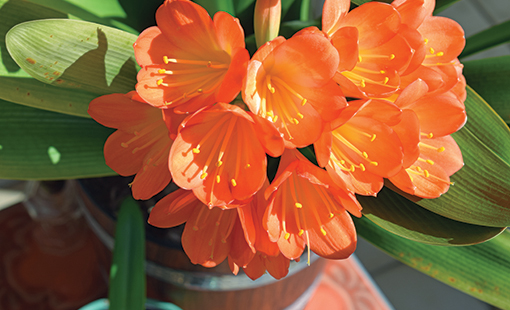
Caring for Clivia Plants
The clivia plant, also known as kafir-lily is a beautiful houseplant you can grow relatively easily. The plant has heavy textured green strap-like leaves. The flowers are smooth petaled, with varied colors ranging from brick red to salmon, red and yellow. It is truly a beautiful indoor houseplant.
The clivia plant is a relative of the amaryllis. It grows from thick, tuberous roots rather than a true bulb, though people often refer to the clivia bulb when they talk about these plants. The “bulb” generally grows slowly. It’s seldom listed in the plant bracket so it may not look gorgeous when you first spot it in the garden center. However, it’s a plant that will last you for years, even more than a decade. It’s not surprising to hear some 15 years and older clivia plants people grow in their homes. It doesn’t deteriorate with age: on the contrary, these old plants can still produce beautiful flowers and only increase in beauty.
Another thing you need to know is that these plants have evergreen foliage and their flowers look stunning. You can use clivia plants to add color to your home and they make a very good investment.
Care Requirements
The first thing you need to know about growing clivia plants is that they require rich potting soil with a bit peat added to the mix. Make sure to never repot your clivia until the fleshy roots have entirely outgrown the pot.
Once it’s established, a clivia plant needs regular food to thrive. You should feed it during its growth period and make sure to provide it with plenty of water. During the growing season, the bulbs require temperatures of about 60 to 80 degrees F. In the winter, tolerable temperatures range between 50 and 55 degrees F.
There are 3 or 4 popular species of clivia plants, as well as several common hybrids. The most popular of them all (and the one that’s most often listed in catalogs) is Clivia miniata. It has its active growth period in early spring to early fall.
During this time (the growing season), your clivia plant will need a lot of warmth, light, water and fertilization. Average home temperatures of about 70 to 75 degrees F and about a ten degree drop at night are the best and will make the plant thrive. These temperatures match the conditions in the plant’s native South Africa.
To make your clivia thrive, it’s best to place it near an east or south window. It will promote good growth.
Resting Your Clivia Plant
In the late fall and early winter you should make your clivia plant rest. Place it in a cool room where temperatures don’t go above 50 degrees F. Since modern homes are generally well-heated during winter, you may have some problem finding a suitable room to rest your clivia. You may use a partially heated porch or glazed-in patio. Another good place is a north wall in a cool basement. While you keep the plant in storage don’t forget to decrease its water supply.
In mid-January bring your clivia to the light. This is when you should give them a good soaking with water. The plant will soon show new center leaves. When the new growth starts, make sure to give your plant a weekly feeding of one fourth strength soluble liquid food. Read the manufacturer’s instructions carefully to determine the right proportions.
Your clivia plant should bloom in April, but it may not flower until June or even early July.
One note about flowers: some people like clivia for its foliage so they keep their plant in the window garden (or a planter) for the whole year. It’s important to note that this won’t hurt the plant. However, your clivia will probably not grow under such treatment. It is less likely to produce annual spring or summer flower crop. If you want your clivia to bloom, make sure to rest it during winter and to move it from the window, as described above.
Potting and Dividing
When planting, remember to place about one inch of drainage material in the pot. Use a soil mix made for amaryllis bulbs (or a similar one).
If you plant your clivia in an 8 inch pot, chances are that you won’t need to repot it for 5 or 6 years. When it develops a new growth each year, make sure to scrape away an inch of the top soil and replace it with fresh soil. This is all you need to do to set it for the year.
To divide your clivia, knock it gently out of the pot. It’s best to use a sharp knife to cut away the offsets. When you do it, make sure that you cut plenty of root with them. Plant the offsets in five inch pots of soil. Leave them in there for at least one whole year.
When growing the offsets, give them the same treatment you give to the older plants. You can use knife to cut through sheathed leaves and attached roots. You can plant these divisions in the same way you plant offsets.
Growing Clivia Outdoors
If you want to grow your clivia plants outdoors, remember to place the pot in a shady area of your garden. You may also use it for landscaping. It’s probably the best to keep it in a container. This way, you can bring it in the house before the first frost.
You may wish to transplant your clivia, but you need to understand that it will usually deter the plant from producing the next year’s blooms. Old plants often have 15 to 20 leaves so you will sometimes be forced to transfer you plant to a new pot.
Information courtesy of SundayGardener.net

 Adams Fairacre Farms
Adams Fairacre Farms